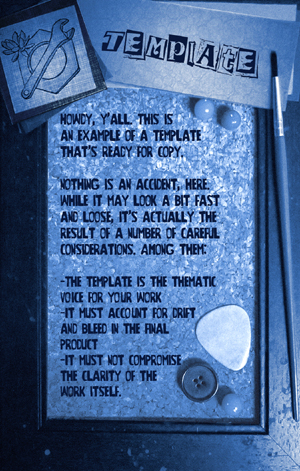If you're in publishing, the answer is no, you're not. Because you have to format your work to its final form. And, for the sake of wound-salting, it'll probably take as long as it took to actually make the art in the first place.
This happens to me constantly, in virtually all media formats. The worst was, of course, the first. Nostos was an absolute beast to format; largely because I wasn't taking proper consideration to the final product. Wilson was doing all the beautiful art, so I figured "done and done," right? Nope. A final product requires a modicum of craftsmanship, not just good art. For cards, the best way to pull the rug out from your craftsmanship is to do the template last; when you're all burned out and just want to be done. I'm lookin' at you, ART168 class at Penn State Behrend.
The template might actually be the most important part, all things considered. It's the first thing your audience sees and the last thing they should notice. It creates a context that must account for the piece as a whole, but still matches the aesthetic and intentionality of each individual piece. If I learned anything from Nostos, it's that the templates shouldn't be the last step, they should be the first. I'm going to illustrate this point with a template I made specifically to make this point:

A quick note: I did not make this template specifically to make this point, but wouldn't that have been cool? It's actually for my MFA portfolio, which I'm formatting as a deck of cards. Regardless, the considerations stand. I'll explain.
-The template is the thematic voice for the work encased within. It makes a case to the audience for why your work is a single entity, a card game, and not just a collection of cards. Used properly, you can drop context, theme, and overall aesthetic into a single piece. For my portfolio template, I'm going for a DIY/lo-fi feel while reminding everyone how much I love bulletin boards and random objects.
-You have to think about drift and bleed. You're not making .jpegs, you're making cards that people are going to hold in their hands. They'll most likely be laser-cut, and the lasers are going to miss by a few millimeters. Let the art bleed outside of the workspace and make sure it looks good while drifting a few millimeters in all eight directions.
-While the templates determine the look and feel of your game, they can't compromise the clarity of the artwork within. You can do bold, and you can do busy, but don't let your art and your template go to war. Also, I need to be able to read your game to play it, so consider a little subtle inside light or shadow on your text.
So, after 2000 headaches, that's what I learned about templates; and I'm passing the savings to you!
xoxo (CW) Alex
PS for ART168: I loved your projects, guys! You are extremely talented artists and designers and your game ideas are a delight to read.
Posted Monday, Feb 24th 2014 @ 15:18
